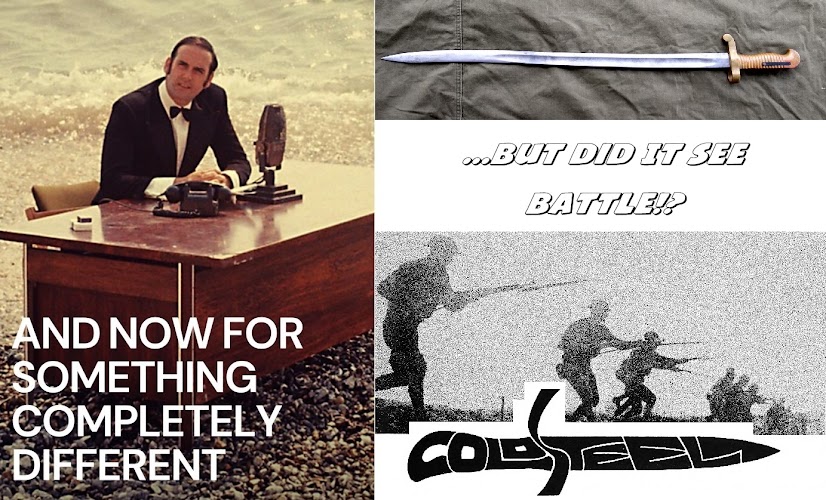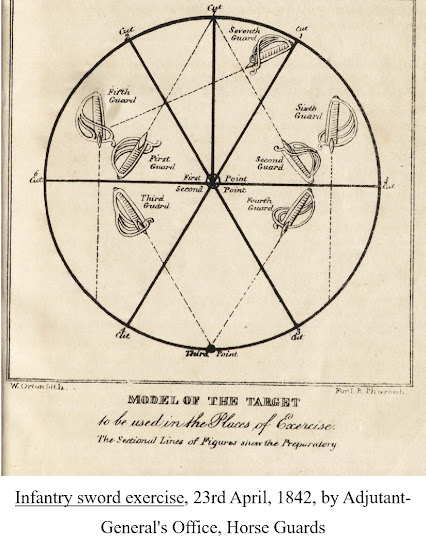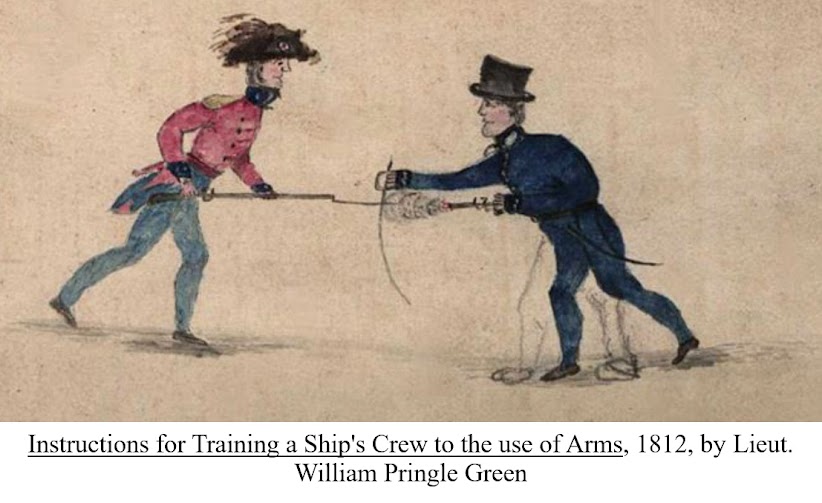Last
week, we found out that the mystery sword that I had purchased, was a Model
1841 Rifle Sword-Bayonet, Colt Alteration bayonet produced by Collins &
Company of Hartford, Connecticut. For
more on how we cracked this mystery, see Part One, HERE.
But did it see battle!?
But
did this sword-bayonet “See The Elephant”, was it ever used in battle? Hmmm... “the game is afoot” as
Sherlock Holmes was fond of saying. Are
there any clues that will help us solve this mystery? The answer is yes if you know what to look for!
First off, the blade is unsharpened. Often military blades were, and still are, issued unsharpened to preserve their uniformed appearance at dress parades and to reduce the risk of training accidents. Historically they weren’t sharpened until just before the soldiers went on campaign. Many military blades that are found today were never sharpened because they were never used.
So, it would appear from the
fact that it is unsharpened, that my sword-bayonet never saw battle. However, especially in the case of American Civil
War bayonets, since many soldiers were only taught how to use the point of
their bayonet, the edges were unsharpened.
But
is there any other evidence that this sword-bayonet ever saw combat, or is this
case closed? No, there are knicks and notches
in the blade, so the game is still afoot!
But the key piece of evidence is three knicks in the blade, all located between the 13th to the 16th inch (33rd to 40th cm) away from the point, which is within the forte or strong part of the sword bayonets blade when parrying. These notches are just beyond the center of percussion or the “sweet-spot” of this sword-bayonet is 9 inches (23 cm) from the tip of the point.
Notch “A” is particularly deep at almost 1/16 of
an inch (just under 2 mm) wide and deep.
The impact occurred on the right side of the blade edge, at a downward angle
of approximately 45o.
The M1841 rifle sword-bayonet attached to the right side of the rifle
barrel ,and the rifle was held with the right hand on the butt near the trigger
guard. This means the edge of the sword-bayonet
is to the rifleman’s right and its right side faces up.
To notch the blade edge in this way, the entire rifle and bayonet
would have to be held above our soldier’s head, and his opponent would have had
to cut obliquely downward, from above, from left to right, at a 45o
angle.
Our soldier, from the guard position (see Figures 1 & 2) would have had to bring his rifle and bayonet up and over his head in such a manner, that the trigger faced upwards to the right and the sword-bayonet’s edge was pointed upwards and perpendicular to the ground. Perhaps he was attempting to parry or thrust (Figures 3 & 17) at a sword wielding cavalry soldier who was either riding past him from left to right, or, more likely, riding past him on his right side, and who slashed with a Cut Two obliquely downwards, from left to right, to bat the bayonet offline.
In either case the sword-bayonet was strongly struck, a mark was left
on the blade, and it would have been knocked offline, allowing our soldier’s
opponent to initiate a counterattack at him.
It is anyone’s guess if our soldier survived, but I think we can safely
say that his sword-bayonet “saw the elephant” and was a veteran of
combat.
I hope that you enjoy learning from this resource! To help me to continue to provide valuable free content, please consider showing your appreciation by leaving a donation HERE. Thank you and Happy Trails!
I
hope that you continue to enjoy The Woodsman’s Journal Online and look for me
on YouTube at BandanaMan Productions for other related videos, HERE. Don’t forget to follow me on both The
Woodsman’s Journal Online, HERE,
and subscribe to BandanaMan Productions on YouTube. If you have questions, as always, feel free
to leave a comment on either site. I
announce new articles on Facebook at Eric Reynolds, on Instagram at
bandanamanaproductions, and on VK at Eric Reynolds, so watch for me.
That
is all for now, and as always, until next time, Happy Trails!
Sources
Adjutant-General's
Office, Horse Guards, Infantry sword exercise, 23rd April, 1842, page
17, https://digitalcollections.library.unsw.edu.au/nodes/view/3078#idx36205,
accessed October 5, 2024
Burton, Richard F.; The
Book of the Sword, [Printed by Spottiswoode & Co, London, 1884], page
126, https://books.google.com/books?id=PgYHAAAAQAAJ&printsec=frontcover&dq=The+Book+of+the+Sword&hl=en&newbks=1&newbks_redir=0&sa=X&ved=2ahUKEwia7MfkhPiIAxVBGVkFHSqLHykQ6AF6BAgLEAI#v=onepage&q=The%20Book%20of%20the%20Sword&f=false,
accessed October 5, 2024
Cary, R. Milton, Lt. Col.
Prov. Army of VA; Skirmisher’s Drill and Bayonet Exercise, [West &
Johnston, Richmond, VA, 1861], Figures 1 to 3 and 17, https://books.google.com/books?id=zMBJAAAAIAAJ&printsec=frontcover&dq=Skirmisher%E2%80%99s+Drill+and+Bayonet+Exercise&hl=en&newbks=1&newbks_redir=0&sa=X&ved=2ahUKEwiwz_SuoviIAxWImokEHUSaKKgQ6AF6BAgMEAI#v=onepage&q=Skirmisher%E2%80%99s%20Drill%20and%20Bayonet%20Exercise&f=false,
accessed October 5, 2024
Green, Lieut., William
Pringle; Instructions for Training a Ship's Crew to the use of Arms,
1812, [Academy of Historical Fencing], https://swordfight.uk/wp-content/uploads/2019/11/Instructions-for-training-a-ships-crew-in-the-use-of-arms-in-attack-and-defence-by-Lieutenant-William-Pringle-Green-1812.pdf,
accessed September 28, 2024
Sargeaunt,
B. E.; “The Development Of The
Sword” The Cavalry Journal, Vol. 1, January to October 1906, [The
Royal United Service Institution, Whitehall S.W., London, 1906], https://books.google.com/books?id=NGhAAQAAMAAJ&pg=PA311&dq=%22centre+of+percussion%22+sword&hl=en&newbks=1&newbks_redir=0&sa=X&ved=2ahUKEwicpL2U0umIAxVWkIkEHdi6Nvg4ChDoAXoECAYQAg#v=onepage&q=%22centre%20of%20percussion%22%20sword&f=false,
accessed October 5, 2024
Unknown,
Instructions For The Exercise Of Small Arms, Field Pieces, Etc., [Printed
by Harrison & Sons, London, 1859], page 95, https://books.google.com/books?id=r1gBAAAAQAAJ&printsec=frontcover&dq=Instructions+For+The+Exercise+Of+Small+Arms,+Field+Pieces,&hl=en&newbks=1&newbks_redir=0&sa=X&ved=2ahUKEwj-oLfW__eIAxVqF2IAHVrAIG8Q6AF6BAgFEAI#v=onepage&q=Instructions%20For%20The%20Exercise%20Of%20Small%20Arms%2C%20Field%20Pieces%2C&f=false,
accessed October 5, 2024
Wikimedia, “Battle of
White Oak Swamp”, 1862, by Alfred Waud, https://commons.wikimedia.org/wiki/File:Battle_of_White_Oak_Swamp.jpg,
accessed October 5, 2024
Wikimedia; “Vertical
study of soldier on horseback (horse is just suggested), with a sword in the
hand of his upraised right arm and the reigns in his left”, by Winslow Homer, 1863,
https://commons.wikimedia.org/wiki/File:Drawing,_Cavalry_Soldier_with_Sword_on_Horseback,_1863_%28CH_18173685%29.jpg,
accessed October 5, 2024













.jpg)




No comments:
Post a Comment